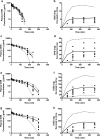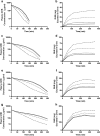Mechanistic toxicokinetic model for gamma-hydroxybutyric acid: inhibition of active renal reabsorption as a potential therapeutic strategy
- PMID: 20461486
- PMCID: PMC2895455
- DOI: 10.1208/s12248-010-9197-x
Mechanistic toxicokinetic model for gamma-hydroxybutyric acid: inhibition of active renal reabsorption as a potential therapeutic strategy
Abstract
gamma-Hydroxybutyric acid (GHB), a drug of abuse, exhibits saturable renal clearance and capacity-limited metabolism. The objectives of this study were to construct a mechanistic toxicokinetic (TK) model describing saturable renal reabsorption and capacity-limited metabolism of GHB and to predict the effects of inhibition of renal reabsorption on GHB TK in the plasma and urine. GHB was administered by iv bolus (200-1,000 mg/kg) to male Sprague-Dawley rats and plasma and urine samples were collected for up to 6 h post-dose. GHB concentrations were determined by LC/MS/MS. GHB plasma concentration and urinary excretion were well-described by a TK model incorporating plasma and kidney compartments, along with two tissue and two ultrafiltrate compartments. The estimate of the Michaelis-Menten constant for renal reabsorption (K (m,R)) was 0.46 mg/ml which is consistent with in vitro estimates of monocarboxylate transporter (MCT)-mediated uptake of GHB (0.48 mg/ml). Simulation studies assessing inhibition of renal reabsorption of GHB demonstrated increased time-averaged renal clearance and GHB plasma AUC, independent of the inhibition mechanism assessed. Co-administration of GHB (600 mg/kg iv) and L: -lactate (330 mg/kg iv bolus plus 121 mg/kg/h iv infusion), a known inhibitor of MCTs, resulted in a significant decrease in GHB plasma AUC and an increase in time-averaged renal clearance, consistent with the model simulations. These results suggest that inhibition of renal reabsorption of GHB is a viable therapeutic strategy for the treatment of GHB overdoses. Furthermore, the mechanistic TK model provides a useful in silico tool for the evaluation of potential therapeutic strategies.
Figures



Similar articles
-
Semi-mechanistic kidney model incorporating physiologically-relevant fluid reabsorption and transporter-mediated renal reabsorption: pharmacokinetics of γ-hydroxybutyric acid and L-lactate in rats.J Pharmacokinet Pharmacodyn. 2015 Oct;42(5):497-513. doi: 10.1007/s10928-015-9441-1. Epub 2015 Sep 4. J Pharmacokinet Pharmacodyn. 2015. PMID: 26341876 Free PMC article.
-
The Drug of Abuse Gamma-Hydroxybutyric Acid Exhibits Tissue-Specific Nonlinear Distribution.AAPS J. 2017 Dec 26;20(1):21. doi: 10.1208/s12248-017-0180-7. AAPS J. 2017. PMID: 29280004 Free PMC article.
-
Renal clearance of gamma-hydroxybutyric acid in rats: increasing renal elimination as a detoxification strategy.J Pharmacol Exp Ther. 2005 Jun;313(3):1194-202. doi: 10.1124/jpet.105.083253. Epub 2005 Feb 18. J Pharmacol Exp Ther. 2005. PMID: 15722403
-
Overview of the proton-coupled MCT (SLC16A) family of transporters: characterization, function and role in the transport of the drug of abuse gamma-hydroxybutyric acid.AAPS J. 2008 Jun;10(2):311-21. doi: 10.1208/s12248-008-9035-6. Epub 2008 Jun 4. AAPS J. 2008. PMID: 18523892 Free PMC article. Review.
-
γ-Hydroxybutyric Acid: Pharmacokinetics, Pharmacodynamics, and Toxicology.AAPS J. 2021 Jan 8;23(1):22. doi: 10.1208/s12248-020-00543-z. AAPS J. 2021. PMID: 33417072 Free PMC article. Review.
Cited by
-
Toxicokinetics/Toxicodynamics of γ-hydroxybutyrate-ethanol intoxication: evaluation of potential treatment strategies.J Pharmacol Exp Ther. 2013 Sep;346(3):504-13. doi: 10.1124/jpet.113.206250. Epub 2013 Jun 28. J Pharmacol Exp Ther. 2013. PMID: 23814094 Free PMC article.
-
Mechanistic modeling of monocarboxylate transporter-mediated toxicokinetic/toxicodynamic interactions between γ-hydroxybutyrate and L-lactate.AAPS J. 2014 Jul;16(4):756-70. doi: 10.1208/s12248-014-9593-8. Epub 2014 May 23. AAPS J. 2014. PMID: 24854892 Free PMC article.
-
Effect of chronic γ-hydroxybutyrate (GHB) administration on GHB toxicokinetics and GHB-induced respiratory depression.Am J Drug Alcohol Abuse. 2017 Nov;43(6):686-693. doi: 10.1080/00952990.2017.1339055. Epub 2017 Jun 29. Am J Drug Alcohol Abuse. 2017. PMID: 28662343 Free PMC article.
-
A Missense Variant in ALDH5A1 Associated with Canine Succinic Semialdehyde Dehydrogenase Deficiency (SSADHD) in the Saluki Dog.Genes (Basel). 2020 Sep 2;11(9):1033. doi: 10.3390/genes11091033. Genes (Basel). 2020. PMID: 32887425 Free PMC article.
-
Effects of monocarboxylate transporter inhibition on the oral toxicokinetics/toxicodynamics of γ-hydroxybutyrate and γ-butyrolactone.J Pharmacol Exp Ther. 2013 Apr;345(1):102-10. doi: 10.1124/jpet.112.202796. Epub 2013 Feb 7. J Pharmacol Exp Ther. 2013. PMID: 23392755 Free PMC article.
References
-
- Roth RH, Giarman NJ. Natural occurrence of gamma-hydroxybutyrate in mammalian brain. Biochem Pharmacol. 1970;19:1087–1093. doi: 10.1016/0006-2952(70)90370-9. - DOI
-
- Hechler V, Ratomponirina C, Maitre M. Gamma-hydroxybutyrate conversion into GABA induces displacement of GABAB binding that is blocked by valproate and ethosuximide. J Pharmacol Exp Ther. 1997;281(2):753–760. - PubMed
Publication types
MeSH terms
Substances
Grants and funding
LinkOut - more resources
Full Text Sources
Other Literature Sources

